
Bonitos are a tribe of medium-sized, ray-finned predatory fish in the family Scombridae – a family it shares with the mackerel, tuna, and Spanish mackerel tribes, and also the butterfly kingfish. Also called the tribe Sardini, it consists of eight species across four genera; three of those four genera are monotypic, having a single species each. Bonitos closely resemble the skipjack tuna, which is often called a bonito, especially in Japanese contexts.

The streaked Spanish mackerel is found mainly in and around India, especially along the Maharashtra and Gujarat coasts. The peak season for fishing this fish is from October to December. It is also known by other names, such as streaked seer, hazard (French), sawara, and carite (Spanish). It is found off Asian coasts from the west coast of India and Sri Lanka east to Java and does not extend east of Wallace's Line. It is an important quarry species for fisheries where it occurs.

The Australian bonito, horse mackerel or little bonito, Sarda australis is a ray-finned fish of the family Scombridae and is found in eastern Australia and New Zealand. They swim at depths reaching depths of approximately 30 m (98 ft), in open water. Its length is commonly at around 40–45 centimetres (16–18 in) fork length and 1.8–2.3 kilograms (4.0–5.1 lb) weight. Its maximum length and weight are about 100 centimetres (39 in) and 9.4 kilograms (21 lb), respectively.

The black flounder, also known by the Māori language name mohoao, is a species of flatfish in the family Rhombosoleidae, found around New Zealand in shallow enclosed waters and coastal freshwater lakes. Its adult length ranges from 20 to 45 cm.

Pacific bonito, Sarda lineolata, is a marine species of bonito that is a game fighter but not highly thought of as a food fish. While it has been considered to be a subspecies of Sarda chiliensis, recent treatments recognize it as a species, S. lineolata.
The Papuan seerfish also called the Papuan Spanish mackerel, is a species of fish in the family Scombridae. It is endemic to the Gulf of Papua off the mouth of the Fly River. It is the smallest species in the genus Scomberomorus. Sexual maturity is attained at much less than 30 cm fork length.
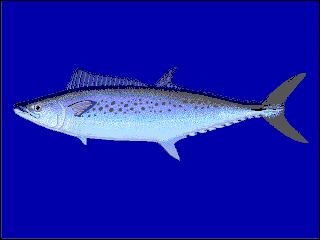
The Australian spotted mackerel is a species of fish in the family Scombridae. Common fork length ranges between 50 and 80 cm. Specimens have been recorded at up to 104 cm in length, and weighing up to 10.2 kg. It is found in the western Pacific, along the northern coast of Australia, from the Abrolhos Islands region of Western Australia to Coffs Harbour and Kempsey in central New South Wales. It is also found in southern Papua New Guinea from Kerema to Port Moresby. It feeds largely on fishes, particularly anchovies and sardines, with smaller quantities of shrimps and squids. It is sometimes confused with Japanese Spanish mackerel, S. niphonius. Conservation status of the species has been evaluated as Near Threatened by the IUCN. This species was described in 1980 and was previously confused with the Japanese Spanish mackerel of the north western Pacific but S. munroi has a different visceral structure, more vertebrae and fewer gill rakers.

The Kanadi kingfish is a species of ray-finned bony fish in the family Scombridae, the mackerel family. Also known as the Kanadi seerfish, queen mackerel, or spotted mackerel, it is found in subtropical waters of the western Indian Ocean, Seychelles, Kenya and Zanzibar to South Africa and along the west coast of Madagascar. Kanadi kingfish commonly occur in depths of 50 to 200 m. Specimens have been recorded at up to 120 cm (47 in) in length, and weighing up to 12.5 kg (28 lb). They feed mainly on small fishes such as anchovies and clupeids, squids, and mantis shrimps.

Cynoglossus canariensis, commonly known as the Canary tonguesole is a species of tonguefish. It is commonly found in the eastern Atlantic Ocean off western Africa, from Mauritania and Western Sahara south to Angola, including the Canary Islands and Cape Verde Islands. It is a demersal species found at depths of 10-300m, it has been found in brackish water, but is normally a coastal species which occurs over substrates of sand or mud. It feeds on small fish and crustaceans. This species is targeted in trawl fisheries throughout its range and in many areas, it appears to have undergone significant declines. For example, in Gabon the mixed Cynoglossus stock is considered overexploited, while in other parts of western Africa such as Mauritania the stocks of Cynoglossus had declined by over 60% in the five or six years up to 2015. The IUCN list C. canariensis as Near Threatened due to is dependence on conservation.
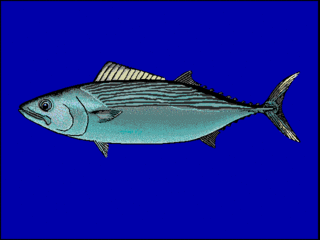
The striped bonito is a species of marine ray-finned fish in the family Scombridae. They have been recorded at lengths of 102 centimetres (40 in), though they are commonly no longer than 55 centimetres (22 in). Distributed through the Indo-Pacific and East Pacific, the striped bonito is known to occur at depths from 1 to 167 metres. They are called mackerel bonito.
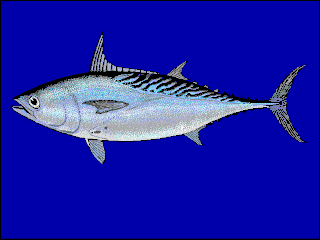
Euthynnus is a genus of ray-finned bony fish in the family Scombridae, or mackerel family, and in the tribe Thunnini, more commonly known as the tunas.

Thunnus tonggol is a species of tuna of tropical Indo-West Pacific waters.

Sarda is a genus of medium-sized, predatory ray-finned fish in the family Scombridae, and belonging to the tribe Sardini, more commonly called the bonito tribe. There are four species which comprise the genus Sarda. One of those species, the Pacific bonito, is further divided into two subspecies.

The leaping bonito is a species of saltwater finfish from the Scombridae (Mackerel) family. Scombridae includes such tribes as the mackerels, tunas, and bonitos – of the latter of which, the Sardini tribe, this fish is a member. It is the only member of the genus Cybiosarda, which is therefore called a monotypic taxon. Since the bonitos and tunas are close relatives, this fish has variously been referred to by such other common names as Australian tuna, striped bonito, and Watson's bonito.

The shark mackerel is a species of Spanish mackerel in the scombrid family (Scombridae). Their maximum reported length is 112 cm (44 in), and the maximum reported weight is 13.5 kg (30 lb).

The island mackerel is a species of true mackerel in the scombrid family (Scombridae) from the Indo-Pacific. Their maximum reported length is 20 cm, and the maximum reported weight is 0.75 kg.

Orcynopsis unicolor, the plain bonito, is a species of ray-finned, bony fish in the bonito tribe of the mackerel family (Scombridae). It occurs in the eastern Atlantic from southern Norway, where it is a vagrant, to Senegal, although it is not found in the seas around the Macaronesian Islands. It is also found in the Mediterranean Sea and extends to the Black Sea.
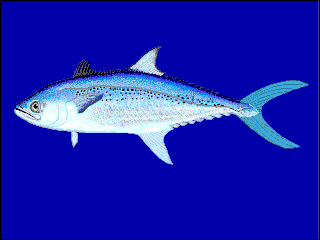
The Korean mackerel also known as the Korean seerfish, is a ray-finned bony fish in the family Scombridae, better known as the mackerel family. Within that family, this fish is a member of the tribe Scomberomorini, the Spanish mackerels. It has an Indo-Pacific distribution which extends from the east coast of India and Sri Lanka along the Asian continental shelf to Sumatra, then north to Korea and Wakasa Bay in the Sea of Japan. This species is of minor commercial importance in some parts of its range, where it is caught using gill nets and is marketed either fresh or dried-salted. The Korean mackerel is an important quarry species for the drift net fishery in Palk Bay and the Gulf of Mannar in India.
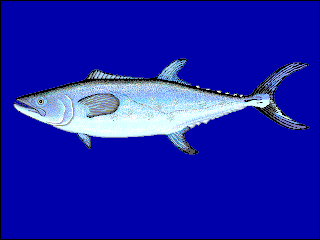
The Chinese mackerel, also known as the Chinese seerfish, is a ray-finned bony fish in the family Scombridae, better known as the mackerel family. More specifically, this fish is a member of the tribe Scomberomorini, the Spanish mackerels. It is a marine species occurring in the Western Pacific Ocean, but it also enters the Mekong River.

Scombriformes, also known as Pelagia and Pelagiaria, is an order of ray-finned fish within the clade Percomorpha. It contains 287 extant species in 16 families, most of which were previously classified under the suborders Scombroidei and Stromateoidei of the order Perciformes.



















